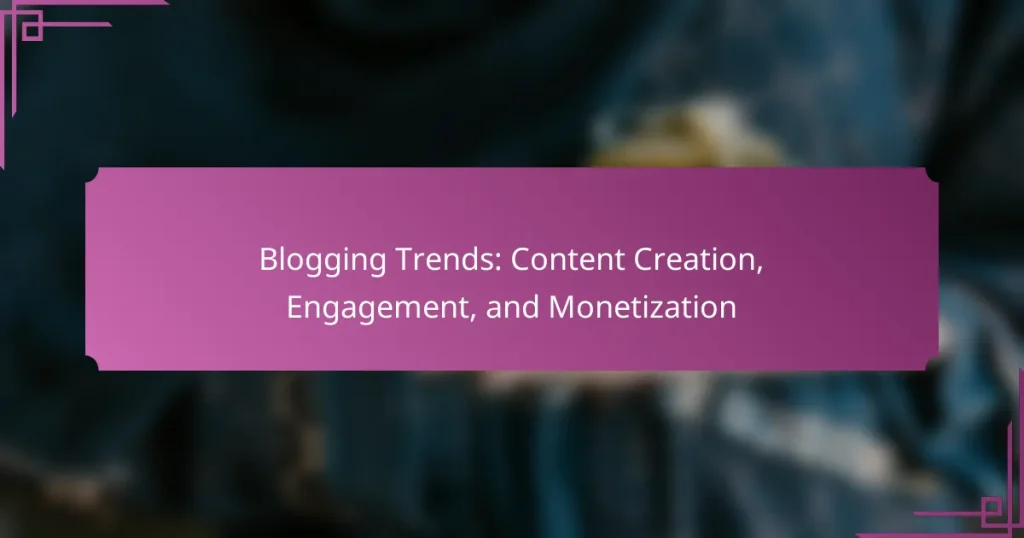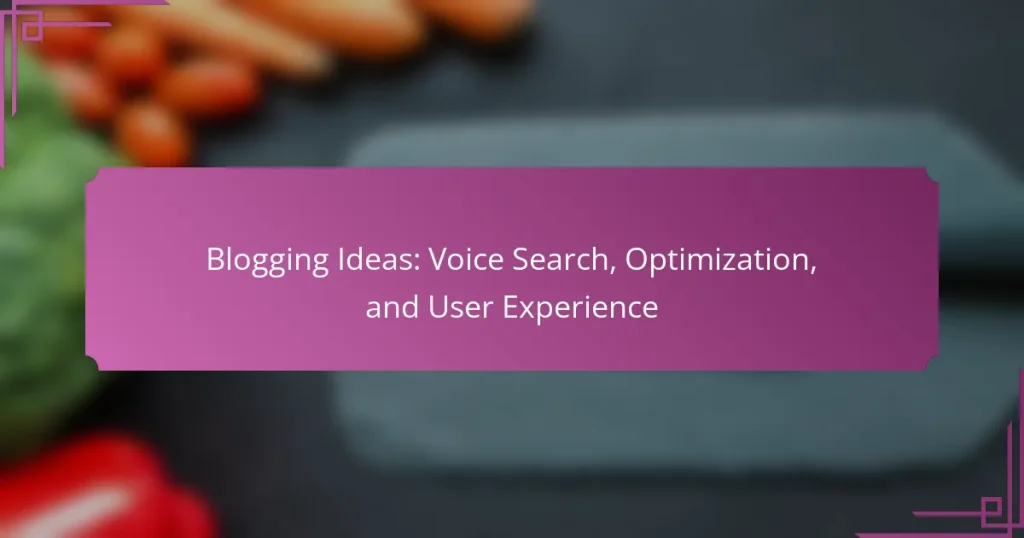Blogging is evolving rapidly, with a strong emphasis on niche specialization and multimedia integration to engage audiences more effectively. As bloggers adopt innovative content formats and leverage technology, they are not only enhancing user experiences but also exploring various monetization strategies to maximize their reach and revenue. Essential tools like content management systems and analytics platforms are becoming indispensable for modern bloggers aiming to streamline their workflow and track performance.
Social Media Trends: Content Impact, Audience Reach, and Engagement
Blogging Ideas: Data-Driven Insights, Audience Engagement, and Content Strategy
Blogging Trends: Content Creation, Engagement, and Monetization
AI Tools: Integration, Efficiency, and Content Quality
Blogging Trends: Adaptation, Strategy, and Market Insights
Blogging Ideas: Voice Search, Optimization, and User Experience
What are the latest trends in blogging?
The latest trends in blogging focus on niche specialization, multimedia integration, and innovative content formats. Bloggers are increasingly adopting strategies that enhance user engagement and cater to specific audiences, leveraging technology to create more dynamic experiences.
Micro-niche blogging
Micro-niche blogging involves targeting very specific topics within a broader category, allowing bloggers to attract a dedicated audience. This approach can lead to higher engagement rates as content resonates more deeply with readers who have particular interests.
For example, instead of a general travel blog, a micro-niche blog might focus solely on eco-friendly travel tips. This specificity helps in building a loyal following and can improve search engine optimization (SEO) by using targeted keywords.
Video content integration
Integrating video content into blogs is becoming essential as audiences increasingly prefer visual media. Videos can enhance storytelling and provide more engaging ways to present information, making the blog more appealing.
Consider including short tutorial videos or vlogs alongside written posts. Platforms like YouTube can be leveraged to drive traffic back to the blog, creating a synergistic effect between video and written content.
AI-generated content
AI-generated content is gaining traction as tools become more sophisticated, allowing bloggers to produce articles quickly and efficiently. While AI can assist in generating ideas or drafting posts, human oversight remains crucial to ensure quality and authenticity.
Bloggers should use AI as a supplement rather than a replacement, focusing on unique insights and personal experiences that AI cannot replicate. Balancing AI assistance with personal touch can enhance credibility and reader connection.
Interactive content formats
Interactive content formats, such as quizzes, polls, and infographics, are effective in engaging readers and encouraging participation. These formats can make the content more memorable and shareable, increasing the likelihood of reaching a wider audience.
For instance, a blog about health could include a quiz to help readers assess their fitness levels. This not only provides value but also encourages readers to share their results, further promoting the blog.
Mobile-first design
Mobile-first design prioritizes the user experience on mobile devices, reflecting the growing trend of users accessing content via smartphones. A mobile-friendly blog layout is crucial for retaining readers and improving search engine rankings.
Ensure that your blog is responsive, loads quickly, and features easily navigable menus. This approach not only enhances usability but also caters to the increasing number of mobile users, which can significantly impact traffic and engagement levels.
How can bloggers monetize their content effectively?
Bloggers can effectively monetize their content through various strategies that leverage their audience and niche. Key methods include display advertising, affiliate marketing, and sponsored content partnerships, each offering unique benefits and considerations.
Display advertising strategies
Display advertising involves placing ads on a blog, typically through networks like Google AdSense. Bloggers earn revenue based on impressions or clicks, making it essential to optimize ad placement for visibility without disrupting user experience.
To maximize earnings, consider using responsive ads that adjust to different screen sizes and experimenting with ad formats, such as banners or in-content ads. Monitoring performance metrics can help identify the most effective strategies.
Affiliate marketing opportunities
Affiliate marketing allows bloggers to earn commissions by promoting products or services through unique referral links. When readers make purchases via these links, bloggers receive a percentage of the sale, making it a performance-based revenue model.
Choosing relevant affiliate programs that align with your content is crucial. Popular options include Amazon Associates and niche-specific programs. Transparency with your audience about affiliate links can enhance trust and encourage clicks.
Sponsored content partnerships
Sponsored content involves collaborating with brands to create posts that promote their products or services. This can be a lucrative way to monetize a blog, as companies often pay well for exposure to targeted audiences.
When pursuing sponsored partnerships, ensure that the content aligns with your blog’s theme and audience interests. Disclosing sponsorships is not only ethical but often required by regulations, such as the FTC guidelines in the United States.
What tools are essential for modern bloggers?
Modern bloggers need a set of essential tools to streamline their workflow and enhance their content. Key tools include content management systems, graphic design applications, and analytics platforms that help track performance and audience engagement.
WordPress for content management
WordPress is a leading content management system (CMS) that powers a significant portion of the web. It offers a user-friendly interface, customizable themes, and a wide range of plugins to enhance functionality. Bloggers can easily create, edit, and publish posts without needing extensive technical knowledge.
When using WordPress, consider the choice between WordPress.com and WordPress.org. The former is hosted and easier for beginners, while the latter offers more control and customization options but requires self-hosting. Ensure you choose a reliable hosting provider if you opt for WordPress.org.
Canva for graphic design
Canva is a popular graphic design tool that allows bloggers to create stunning visuals without needing advanced design skills. It offers a drag-and-drop interface and a vast library of templates, images, and fonts, making it easy to produce eye-catching graphics for blog posts and social media.
To maximize Canva’s potential, utilize its brand kit feature to maintain consistent branding across all visuals. Additionally, consider using Canva’s resizing tool to adapt designs for various platforms, ensuring your graphics look great whether on a blog, Instagram, or Facebook.
Google Analytics for performance tracking
Google Analytics is an essential tool for bloggers to track website performance and user behavior. It provides insights into traffic sources, audience demographics, and engagement metrics, helping bloggers understand what content resonates with their audience.
To effectively use Google Analytics, set up goals to measure specific actions, such as newsletter sign-ups or product purchases. Regularly review your analytics dashboard to identify trends and adjust your content strategy accordingly. Familiarize yourself with key metrics like bounce rate and average session duration to gauge user engagement effectively.
What are the best practices for SEO in blogging?
Effective SEO practices in blogging focus on improving visibility and driving organic traffic. Key strategies include thorough keyword research, on-page optimization, and robust link-building efforts.
Keyword research techniques
Keyword research is essential for identifying the terms and phrases your target audience uses. Utilize tools like Google Keyword Planner, Ahrefs, or SEMrush to discover relevant keywords with good search volume and manageable competition.
Consider long-tail keywords, which are typically more specific and less competitive. For example, instead of targeting “shoes,” aim for “best running shoes for flat feet.” This approach can lead to higher conversion rates as it attracts a more focused audience.
On-page SEO optimization
On-page SEO involves optimizing individual blog posts to rank higher in search results. Start by including your primary keyword in the title, headings, and throughout the content, ensuring it flows naturally.
Other important elements include optimizing meta descriptions, using alt tags for images, and maintaining a user-friendly URL structure. Aim for a clear hierarchy in your content with headings and subheadings to enhance readability and engagement.
Link-building strategies
Link-building is crucial for establishing authority and improving search rankings. Focus on acquiring backlinks from reputable sites within your niche through guest blogging, collaborations, or creating shareable content.
Engage with your audience on social media and forums to promote your blog and encourage organic link sharing. Avoid black-hat techniques like buying links, as these can lead to penalties from search engines.
How can bloggers enhance user engagement?
Bloggers can enhance user engagement by actively involving their audience through interactive content and community-building strategies. This approach not only fosters a sense of belonging but also encourages readers to return and participate regularly.
Utilizing social media platforms
Social media platforms are essential tools for bloggers to boost user engagement. By sharing blog posts, engaging in conversations, and responding to comments, bloggers can create a dynamic presence that attracts and retains readers. Platforms like Instagram, Twitter, and Facebook allow for real-time interaction, which can significantly increase visibility and engagement.
To maximize effectiveness, bloggers should tailor their content to each platform’s unique audience. For instance, visual content works well on Instagram, while Twitter is ideal for quick updates and discussions. Regularly posting and interacting with followers can lead to a loyal community and higher traffic to the blog.
Creating community forums
Establishing community forums is another effective way to enhance user engagement. These forums provide a space for readers to discuss topics related to the blog, share experiences, and ask questions. By fostering a sense of community, bloggers can encourage deeper connections among their audience.
When setting up a forum, consider using platforms like Discourse or integrating a forum feature directly into the blog. Ensure the forum is user-friendly and actively moderated to maintain a positive environment. Regularly participating in discussions and highlighting valuable contributions can further strengthen community ties and keep users engaged.






